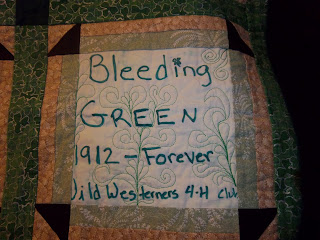I spent a full weekend on this project, but I'm pleased with the results. I think I mastered this paper pieced block. I took photos to help me describe each step so others can learn to do this beautiful Mariners Compass block.
First I determined that I needed a block that is 19.5" squared. I taped two pieces of parchment paper together to be large enough and then cut the square. Now there were several other instructions that I found instructing you to draw lines to dissect the square. However, I found it much simpler to fold the square in half and half again. This would give you the four square quadrants. Then I unfolded. Next I fold in half from corner to corner and in half again to the opposite corners. Hopefully my photo is clear enough that my folds can be seen.
There are a lot of great books out there that help you understand how to draw out any style Mariners Compass you desire. Then I dissected my pattern into sections. I traced a section from one large point to the next. Then using my copier I copied each section for paper piecing.
Here are the four bocks I came up with that made since for paper piecing. The two large point styles I made four copies and the two group blocks I needed eight copies.
Next to choose my fabrics. I wanted a darker back ground with bright colors for the points to pop.
The first small group. You do need a basic understanding of paper pieced quilt blocks to do this.
Second block, just like first but with the additional medium point.
Now the fun begins.
Now that each block is complete, it's time to assemble the blocks. Using a pin; poke pin through point of one block at top of seam and push through the second block where seam is to join up. This aligns the blocks with accuracy. (see two above photos, front and back)
This is what the blocks should look like before you sew.
First completed assembly
Fold out and iron. Insure that seams are lined up and that you have left a 1/4" (apx) at the top for future assembly.
Starting to lay out blocks to get an idea of final assembly
Attach the next block.
Attach largest point to make complete unit
Attach one small black to each complete block.
Final Assembly of paper pieced unit (with out appliqued center) from front. The back view in photo below show all the paper still on block and what that will look like.
Remove the paper. Remember the smaller your seam the easier to remove the paper. Note to self - don't get the paper wet next time and it'll come off easier with out such a mess. FYI I sometimes spritz my blocks with water to seam them really good for crisp seams. I don't advice this with paper pieced blocks.
The finished assembly with appliqued center. Now I just need to lay this out and trace for my back ground to make this a square. This was a practice piece as I didn't want to waste the fabric for my son's Lone Star quilt. Now that I've practiced one (I'll have to find a use for this one) I can do the real thing for his quilt.
 First I drew up this design on butcher paper. Then I ironed it to the block below and stitched over that, tracing each line. Learned a lesson with this one......never use pencil. I've used pencil on parchment paper and had some transfer of the lead to the thread, but with butcher paper it was worse. In the future I will draw my designs on other paper and then trace it on the butcher paper with sharpie fine point pen.
First I drew up this design on butcher paper. Then I ironed it to the block below and stitched over that, tracing each line. Learned a lesson with this one......never use pencil. I've used pencil on parchment paper and had some transfer of the lead to the thread, but with butcher paper it was worse. In the future I will draw my designs on other paper and then trace it on the butcher paper with sharpie fine point pen.








































.jpg)
.jpg)
.jpg)
.jpg)
.jpg)
.jpg)
.jpg)
.jpg)
.jpg)
.jpg)
.jpg)
.jpg)
.jpg)
.jpg)
.jpg)
.jpg)
.jpg)
.jpg)
.jpg)